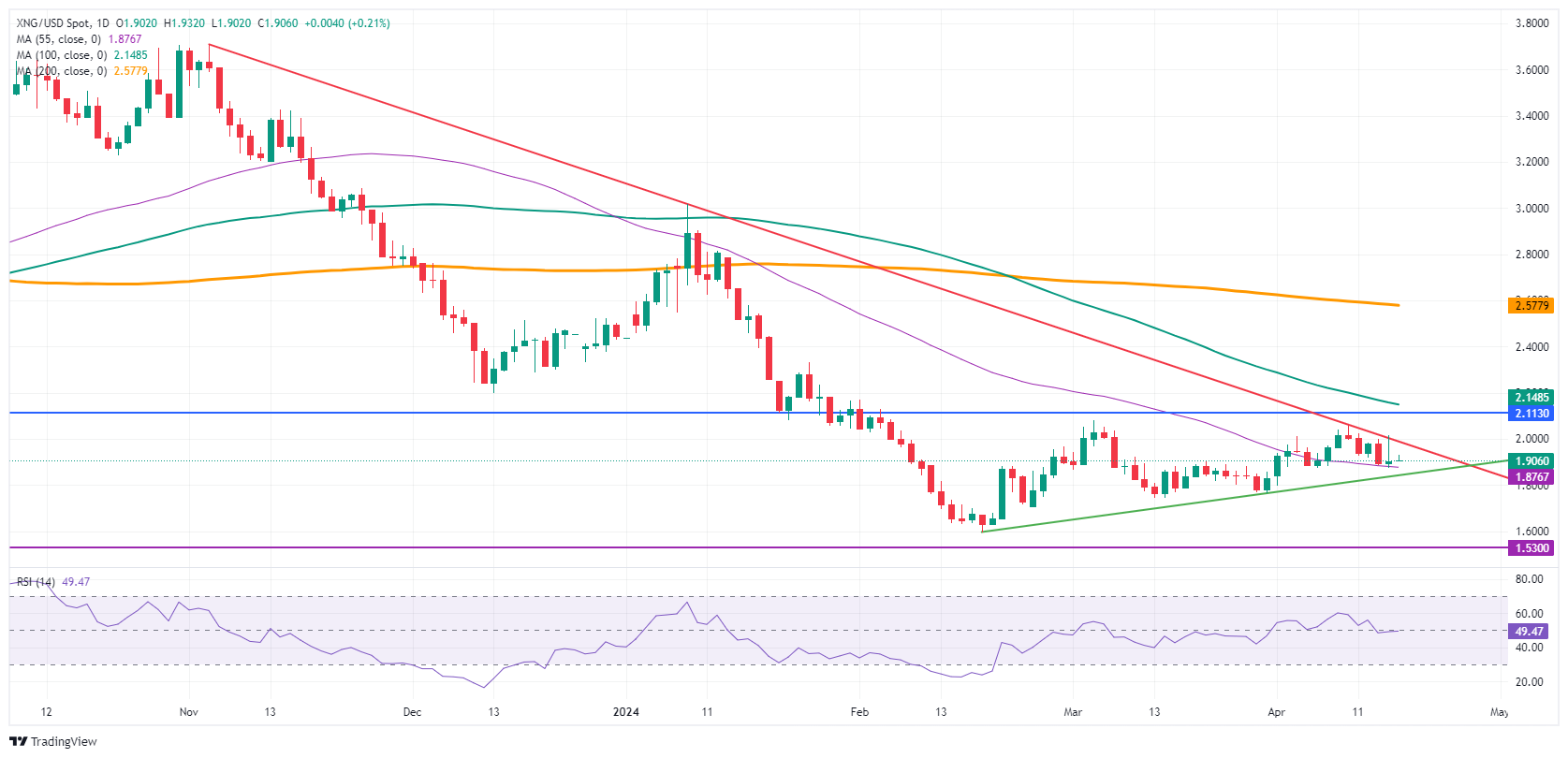- Natural Gas prices remain stable on Wednesday, but futures rise in European markets.
- Markets perceive tensions amid uncertainty about Israel's retaliation against Iran.
- US Dollar Index consolidates after Fed Chairman confirms delay in interest rate cuts.
Natural Gas (XNG/USD) is trading flat in a tight range on Wednesday, digesting overnight headlines about persistent tensions in the Middle East. White House National Security Advisor Jake Sullivan told Bloomberg that the outline of sanctions against Iran will come in the coming days and will specifically focus on the country's drone plan. Meanwhile, in the Middle East, Saudi Arabia's Crown Prince Mohammed Bin Salman and UAE President Mohammed Bin Zayed Al Nahyan issued a rare joint statement calling for self-restraint and pointing out the dangers of war. .
Meanwhile, the US Dollar Index (DXY) weakens after its astonishing five-day winning streak. Further easing is expected with a very light economic calendar and markets no longer seeking to force the US Federal Reserve to change its stance. US Federal Reserve Chairman Jerome Powell stated on Tuesday that current inflation levels do not require a rate cut, suggesting that interest rates will remain stable for longer until inflation get off
Natural Gas is trading at $1.90 per MMBtu at the time of writing.
News about Natural Gas: A war that nobody wants
- The Barrow North LNG terminal in the United Kingdom is undergoing an unplanned maintenance call. Meanwhile, Gas flows from Norway to Europe are recovering after a series of unforeseen cuts in some of its main fields.
- Gas futures in Europe have risen 20% in just five days. However, prices are likely to decline as Norwegian flows return to normal volumes.
- European Gas tanks are 62% full and will be replenished during the summer.
- On Wednesday, markets will continue to watch Israel's retaliatory measures against Iran.
Technical analysis of Natural Gas: A brief pause, enjoy it while it lasts
Natural Gas prices are going through a moment of calm on Wednesday, while Israel's next steps regarding Iran are not known. The pause should give prices some room for a small pullback, although nothing substantial. With the risk of what happens in the Middle East in the spotlight, it is expected that the main support barriers will remain intact.
To the upside, the red descending trend line at $1.99-$2.00 looks ready for another test. If Gas prices surpass it, there could be a quick rally to $2.11. Not so far away, the $2.15 zone of the 100-day SMA becomes the main resistance level.
On the downside, the 55-day SMA around $1.88 should be a safety net. Next, the green ascending trend line near $1.83 should support the rally since mid-February. If even this level were to be broken, a drop to $1.60 and $1.53 would not be impossible.

Natural Gas: Daily Chart
Frequently asked questions about Natural Gas
What fundamental factors determine the price of Natural Gas?
Supply and demand dynamics are a key factor influencing Natural Gas prices, and in turn are influenced by global economic growth, industrial activity, population growth, production levels and inventories. Climate influences Natural Gas prices because more Gas is used during cold winters and hot summers for heating and cooling. Competition from other energy sources influences prices as consumers may opt for cheaper sources. Geopolitical events, such as the war in Ukraine, also play a role. Government policies related to extraction, transportation and environmental issues also influence prices.
What are the main macroeconomic publications that influence Natural Gas Prices?
The main economic publication that influences Natural Gas prices is the weekly inventory bulletin of the Energy Information Administration (EIA), a US government agency that produces data on the gas market in the United States. The EIA Gas bulletin usually comes out on Thursday at 14:30 GMT, the day after the EIA publishes its weekly Oil bulletin. The economic data of the large consumers of Natural Gas can influence supply and demand, among which China, Germany and Japan stand out. Natural gas is primarily priced and traded in US dollars, so economic releases affecting the US dollar are also factors.
How does the dollar influence Natural Gas prices?
The US dollar is the world's reserve currency and most commodities, including Natural Gas, are quoted and traded in international markets in US dollars. Therefore, the value of the Dollar influences the price of Natural Gas, since if the Dollar strengthens, fewer dollars are needed to buy the same volume of gas (the price falls), and vice versa if the dollar strengthens.
Source: Fx Street
I am Joshua Winder, a senior-level journalist and editor at World Stock Market. I specialize in covering news related to the stock market and economic trends. With more than 8 years of experience in this field, I have become an expert in financial reporting.







